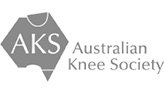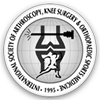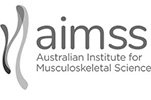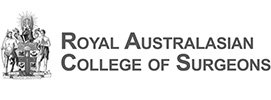Knee Replacement
This information sheet is designed to help you to understand what a knee replacement involves.
For more information go to my website www.kneesurgeonmelbourne.com.au
I perform knee replacements frequently, several times each week, and my commitment to you is to perform the surgery to the highest possible professional standards using the best available equipment, components, staff, and hospitals. If you have any problems or concerns at any stage please let me know so we can work together to achieve the best possible outcome.
Knee replacement is a commonly performed operation for severe knee symptoms usually caused by osteoarthritis.
Osteoarthritis is a gradual process in which the surfaces of the knee become damaged and wear away. The bones on either side of the knee joint are usually covered with a hard, smooth layer of cartilage that protects it and allows the surfaces to glide smoothly over each other. This surface can be damaged by injury or general wear and tear. When the process becomes advanced the underlying bone is uncovered. This causes pain, swelling and stiffness because the surface is no longer smooth and the nerve endings in the bone are exposed.
Osteoarthritis of the knee is a very common condition. It can occur in young people following injuries, but most commonly occurs in older people. Factors that cause osteoarthritis include previous knee injury, obesity, and a family history of osteoarthritis.
Knee replacement should be considered a last resort for the treatment of knee osteoarthritis. When deciding whether to have a knee replacement it is important for you to balance the severity of the current symptoms against the risks and expected outcomes from having surgery. Most people who have knee replacements are very happy, however, it is a big operation and the results can be variable.
For further information regarding arthritis refer to the Arthritis Australia website https://arthritisaustralia.com.au/what-is-arthritis/
Knee Replacement
You will be admitted to hospital on the morning of your operation. The nursing staff will meet you on your arrival. One of the hospital medical doctors will review you during your stay to monitor your general health. The anaesthetist will see you on the morning of your operation and go over your medical conditions and discuss the anaesthetic. I will see you on the day of your operation, before the surgery, and draw an arrow on your knee to confirm which side we are operating on and to answer any of your questions.
Your operation is performed under an anaesthetic. This can be either a spinal anaesthetic (injection in the back) or a general anaesthetic (completely asleep) or a combination of both. The risks of the anaesthetic will be explained to you prior to your operation by the anaesthetist. Your risks associated with the anaesthetic are largely related to your general health, so please let us know about all of your medical history. We need to know about any problems you may have experienced with previous anaesthetics, diabetes, heart conditions and any blood thinning tablets that you may be taking (such as Plavix, Clopidigrel and Warfarin). These will need to be stopped or replaced some days prior to surgery. I am usually happy for people to stay on Aspirin.
Your operation takes approximately 90 minutes to complete. It requires a long incision over the front of the knee. The muscles are split and the knee is exposed. The worn surfaces of the knee are removed and replaced with metal and plastic surfaces that are attached to the bone. The ends of the femur (thigh bone) and tibia (shin bone) are always replaced. The undersurface of the patella (kneecap) is also replaced in most cases – you keep your kneecap but have a smooth plastic surface attached to the underside of it. At the end of the operation I inject local anaesthetic around the knee to numb it as much as possible.
After the operation
Once the operation is completed I will call your contact person to let them know that we have finished the surgery. It is likely that you will be away from the ward for about four hours in total due to time preparing for the surgery and recovering afterwards.
After the operation you will wake up in the recovery room with a large bandage on your knee. After an hour in the recovery ward you will be transferred back to your room on the ward. The injections to numb your knee will wear off during the first night after the surgery. It is common for your knee to become very sore for the first couple of days after the surgery. You will be offered a selection of pain killers and most people will require strong opiate painkillers such as palexia or oxycodone for the first few days after the surgery. If you require more pain killers at any stage talk to your nurse. The strong painkillers often lead to side effects such as nausea, constipation and feelings of dizziness or disorientation. The hospital physician and I will review you regularly so please let us know if you have any concerns.
Occasionally some patients have problems passing urine after surgery. This is due to the anaesthetic. If this occurs a urinary catheter is used to drain your bladder. This is a thin rubber tube which is inserted into your bladder to allow urine to drain freely. Usually it is inserted on the ward after the operation, although occasionally it is inserted during the operation if we feel that there is a high risk of your bladder becoming overfilled. Most people find that the insertion of a catheter is only mildly uncomfortable and are quite relieved when their bladder is emptied. The risk of requiring a catheter is higher in people with previous urinary problems such as symptoms from prostate problems or incontinence so please let us know if you have had any problems with urination.
The morning after the operation a blood test will be done to check how much blood you have lost during your operation. If your blood count is low a transfusion may be recommended.
This is rare and occurs in less than 2% of patients.
The physiotherapists will see you and explain the exercises that you will need to perform. They will also get you to stand up and take your first steps on your new knee. Not only is it completely safe to stand on the knee, it is important that you are out of bed and moving as soon as possible.
You are likely to be in hospital for several days after the operation (four days is the average). This time is spent working to get the knee bending and straightening, and learning to walk on it again using a walking frame or crutches. It is normal for the knee to be very swollen and bruised after the operation.
I will see you most days after the surgery. Occasionally I will have one of my colleagues covering for me if I am unavailable. In addition, a medical physician is assigned to monitor your general health during your stay.
At the end of the time in hospital most people can walk using crutches and negotiate a few stairs. You should be able to largely look after yourself at home, however, it is always beneficial to have someone at home to help. You have the option of being transferred to one of the inpatient rehabilitation hospital s for more time in hospital to recover from the surgery. This usually involves an additional 10 days in hospital. It is particularly useful for patients who live alone or are older or more frail. The most common rehabilitation hospital we use is Donvale Rehabilitation Hospital, but Dorset and Brunswick are also frequently used. Referral to one of these hospitals is made by the ward nurses in the first day or two after the surgery.
Before you go home the physiotherapists will give you series of exercises to perform every day. In addition they will help you organise ongoing outpatient physiotherapy. This can either be with the hospital physiotherapists (Physiocare) or with a physiotherapist of your own choice.
Your follow-up appoint will have been made for 4 weeks after your surgery. If you are unsure please contact my office to confirm.
Going Home
A knee replacement is a big operation and it is normal for your knee to be sore for several weeks after the operation. However, the amount of pain experienced varies a lot between patients. You will be sent home with some pain-relieving tablets. You may need to take these for several weeks. It is best to cut back on the stronger tablets such as Oxycontin/Targin and Oxynorm/Endone/Palexia as soon as possible. If you require more tablets contact my rooms or your own GP. Take regular Panadol. Rest, elevation, and ice packs can also help to reduce the pain and swelling.
It is very important to regain as much movement of the knee as soon as possible after the surgery. While these exercises may cause some pain and swelling around the knee, they are safe to do and will not do any harm to your new knee.
If the knee starts to become increasingly painful after you have gone home try resting it, putting on an ice pack and taking some pain relief. If it doesn’t settle or you develop any signs of an infection, such as a temperature or increasing redness around the knee, then contact my office (ph. 9459 6611), the hospital, your GP or local emergency department.
You may be sent home with an adhesive dressing. The large adhesive dressing is usually removed prior to leaving hospital. Underneath this is a narrow, clear adhesive strip which is glued onto the wound. This strip usually stays on for 2-3 weeks. At that time it will often start to peel of and it can be easily removed. If it is still on when I see you at 4 weeks I will remove it (it is not painful to remove). If there is any ongoing bleeding or leaking from the wound after you get home or any signs of infection please contact my rooms. The stitches in your knee are all absorbable, and do not need to be removed.
When I see you four weeks after the operation I will check the movement and strength of your knee. It is common at this stage for the knee to still be quite sore and swollen, but it should be steadily improving. At four weeks after your surgery, many people are still using one or two crutches but it is safe to be walking without them if you feel stable. At four weeks we like to see that you have at least 90 degrees of flexion (bending) and can get the knee almost straight. It can take longer to get the knee completely straight.
The full recovery from a knee replacement takes at least three months. While most patients are very happy with their knee the result can be variable. From the research we have published we have shown that around 95% of patients are satisfied with the outcome of the surgery. The usual result is to have a knee which has no pain, however, most patients will still be aware of their knee replacement at times. This may include clicking or feelings of tightness. There will also be a numb area in the skin beside scar. Kneeling after knee replacements can be uncomfortable. Most people can walk well for long distances and negotiate stairs comfortably. As far as sporting activities most people can play golf, bowls, gentle tennis, swim, and ride a bike. Very few people can run after a knee replacement. A small percentage of people have ongoing pain or stiffness after knee replacement and are unhappy with the result. If this occurs please come back to see me as we often can improve the symptoms.
The final range of motion of the knee after a replacement is also variable. The average range is from full extension (straight) to about 115 degrees of bending. Very few knees ever gain full bending after replacement and it is possible to have less movement of the knee after replacement than beforehand.
Some complications of knee replacement:
- Occasionally the result from a knee replacement is not as good as we would like due to persisting pain and/or stiffness. In these cases we will investigate with x-rays and scans to try and find the reason. Sometimes we can find the problem and fix it with physiotherapy or injections or further surgery, including bending your knee for you under a brief anaesthetic.
- Infection in the knee replacement can occur. It can require further surgery to wash out the infection. If the knee replacement becomes infected it may need to be completely removed and replaced with a new one. Infection is more common in patients who are overweight or who have diabetes. It can occur after the initial surgery or much later due to transfer of an infection from somewhere else in your body. One possible source of infection is from infected teeth so it is useful to let your dentist know that you have had your knee replaced so they can take precautions.
- DVT (deep vein thrombosis) is a blood clot that forms in the leg veins and can occasionally break off and go to the lungs (pulmonary embolism). It can happen after any surgery and usually causes increasing pain in the calf muscle a few days after the surgery. To decrease your risk of a DVT you will be given injections (Clexane) after your surgery and then will be sent home on a blood thinning table (Xarelto) which you need to take for 14 days. DVT is more common in people who have had one before, so let us know if you have experienced a DVT previously.
- Tender scars and numb patches – the long skin incision will cut small skin nerves causing a tender spot or a numb area in the skin next to the scar. This tends to get smaller and less uncomfortable with time. If you have persisting severe pain in the scar, please come back to see me for review so that I can treat it.
- Nerve or blood vessel damage is a very rare but very serious complication of knee replacement. If the nerves to the leg are damaged it can cause paralysis and loss of feeling. If the blood vessels are damaged they may need to be repaired and there is a risk that the leg may not get enough blood flow. Luckily this is extremely rare.
- As the knee replacement is a mechanical joint it can wear out or become loose over time. If this happens part or all of the knee replacement may need to be changed. It is very uncommon for this to happen in the first 10 years and approximately 85-90% knee replacements are likely to last more than 20 years.
If you have any further questions after reading this information please contact my rooms and arrange another time to talk to me. I also suggest that you read the accompanying College of Surgeons handout on Knee Replacement for further details.
Checklist for knee replacement
- Confirm the correct date with the hospital – they will also call you a day or two before your operation.
- Contact your insurance company to confirm that you are covered for knee replacement. They will ask you for the Item Number for the operation, which is likely to be 49518. This is important as we frequently have patients cancelling at the last minute when they find that their insurance is inadequate. If you have any concerns contact my office for advice.
- Check the “Cost of Surgery” link on my website if you have any questions about cost – or call my secretaries.
- Dental work – please visit your dentist to get any damaged or diseased teeth treated prior to knee replacement. This will decrease your risk of having an infected knee replacement.
- Preadmission blood tests – these usually are a routine series of blood tests and an ECG. The tests should be done between one and two weeks prior to the surgery.
- Stop taking blood thinning tablets - for example Plavix and Warfarin will need to be stopped several days prior to the operation so call my office to confirm details.
- Avoid infections – if you have any scratches or broken skin on your legs or any infections anywhere in your body (including urinary infections and dental infections) your surgery may need to be delayed. So let us know if you have any problems in the days before you come to hospital.
- Bring all of your usual medications to the hospitals.
If you have any problems or concerns about your knee replacement surgery please let me know so we can work together to get you the best possible outcome.
"Any surgical or invasive procedure carries risks. Before proceeding, you should seek a second opinion from an appropriately qualified health practitioner."










